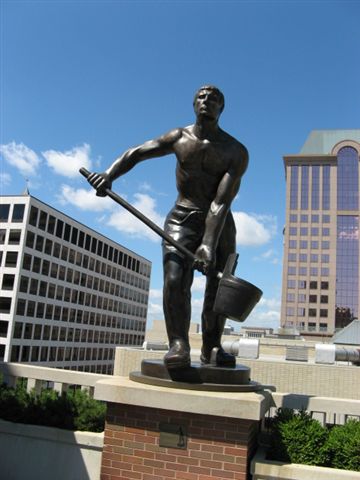I stopped in this morning to see the Grohmann Museum’s new exhibit.
Although it opened May 27, I’ve only been in the building since then during hours when the gallery is closed. Last week was finals, and between holing up to grade over the weekend while also prepping to lead my Great Books event Wednesday evening (we talked about Annie Baker’s The Flick, which won the 2014 Pulitzer Prize for Drama), I just haven’t been around much in the daytime.
First of all, by the way (and just because . . .), here’s a photo I took of the Grohmann’s entrance atrium as I left the building around 9:00 Wednesday evening after dropping my laptop and other materials at my office when Great Books ended. The “gloaming” twilight made everything more striking somehow than it is during the day. The general public is never inside the museum at night except during Gallery Night, and then all the inside lights are on, meaning you’d never be able to see this exact view anyway, with the bluish-purple evening light illuminating the staircase through the arc of glass walls. So I thought I’d share![:)]()
![Grohmann Museum entrance atrium at twilight image]()
Okay, back to the new exhibit. It’s called “Milwaukee’s Industrial Landscapes: Paintings by Michael Newhall” and it runs May 27–August 21.
![image]()
The showpiece of the exhibit is a massive 9-panel panorama of Milwaukee’s Walker’s Point neighborhood. It takes up a whole wall by itself! I couldn’t resist taking a “panorama of the panorama” just to see what it would look like. It’s pretty cool! (You can click on the photo to enlarge it to full screen.)
!["Walker's Point Pan, 1984-87" by Michael Newhall]()
![image]()
And then there’s also this other painting I liked that struck me as really different and intriguing.
!["Alley Behind Factory, Chicago, 1983" by Michael Newhall]()
![image]()
You may be able to experience what I’m getting at if you click on the photo of the painting above to enlarge it. (Don’t double click, for you’ll get an enlargement so huge you can see the canvas weave, which is sort of fun but also way too big for the point I’m making![:)]() ) Or you can just look at the smaller section enlarged below (or even click on it to get a larger version of just this portion of the painting, if you like.)
) Or you can just look at the smaller section enlarged below (or even click on it to get a larger version of just this portion of the painting, if you like.)![image]()
Look at how crisp the detail of the two houses is compared to the trailing tree branches in the foreground and the factory building in the background. It’s like this painting somehow approximates the shallow depth of field you might see in a photograph taken with a telephoto lens. I’ve never noticed a painting do this before (possibly because I just don’t visit enough galleries and museums), and I really like the effect this technique has on the painting.
Or maybe I should say on the viewer’s experience of this painting.
When I focus my gaze on the chimneys of the yellow house, suddenly the foreground and middle ground elements seem to come closer to me while the cocoa-colored factory in the background simultaneously recedes and rushes forward. Your mind’s eye recognizes the building’s distance while also perceiving its abnormally close presence and mass. It’s a very odd, disconcerting sensation of almost physical movement.
Can you feel it, too?
![]()
![]()





![IMG_0213[1]](http://katherinewikoff.files.wordpress.com/2013/04/img_02131.jpg?w=640&h=853)
![IMG_0210[1]](http://katherinewikoff.files.wordpress.com/2013/04/img_02101.jpg?w=307&h=409)
![IMG_0214[1]](http://katherinewikoff.files.wordpress.com/2013/04/img_02141.jpg?w=640&h=853)



















![IMG_1626[1]](http://katherinewikoff.files.wordpress.com/2016/04/img_162611.jpg?w=113&h=150)










 )
)











